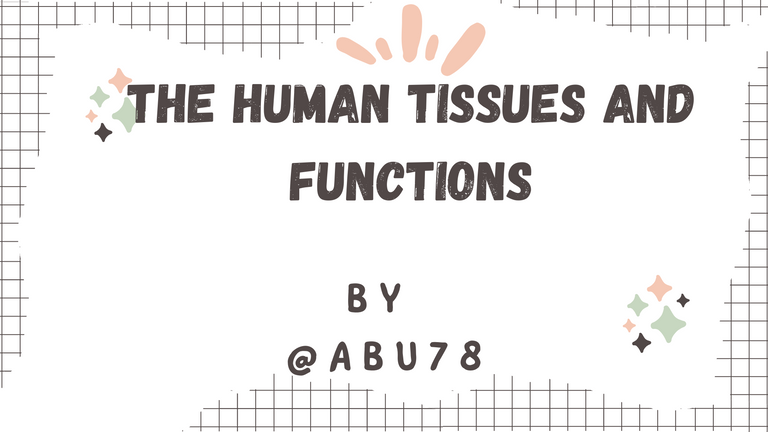The Human Tissues, the types and their functions
Greetings to all and sundry on this platform once again. As a biochemistry student, today I did my research on "The Human Tissues" and decided to share it with you guys here. I hope that you will enjoy it and also learn from it. Stay tuned with me as I discuss this topic in my article

Tissues
Tissues are formed from the smallest basic function of human which is the cell. This indicates that cells comes together to form tissues. Histology is the branch of sconce or biology that deals with the study of tissues. Similarly when tissues are grouped together, they form what we termed as organs and these organs are also grouped together to form system which each performing a specific function.
The types of tissues include the following; connective tissues, nervous tissues,epithelial tissues and muscular tissues. We would look at each of these types here in this article.
Epithelial Tissues
These are tissues that lies on basement membrane and are closely packed with no intercellular spaces. Epithelial tissues covers then body lining cavities. They also covers both the inside and outside lining including heart chambers, blood vessels, urinary tract, and gastrointestinal tract. Epithelial tissues are found on both the skin and also in glands.
Functions of the epithelial tissues
They serve as the removal of waste such in the skin. They also provide the excretion of gastric juice in the stomach. Epithelial tissues are also responsible for defense and the protection of body organs. Epithelial tissues are responsible for the absorption of digested food in the small intestine.
Epithelial tissues are divided into simple and stratified epithelial tissues. The simple epithelial tissues consist of one layer of identical cells and are subdivided into three which includes; squamous, cuboidal, and columnar.
On the other hand, the stratified epithelial tissues are made of up of several layers of cells. This sub-type of epithelial tissue is responsible for protection of cells agains wear and tear.
Next we have the connective tissues. These are the most abundant tissue in the human body. They have large amount of matrix content and also are separated from each other unlike that of epithelial tissues that are closely packed. They contain mast cells, fat cells, leukocytes, fibroblast and macrophages. Functions of connective tissues include the following; function as protection and insulation. They also provide support and serves as storage tissues. They also help in transporting materials from one of the body to another.
There are several types of connective tissues and they include; cartilages, bones, adipose tissues, dense connective tissues, reticular tissues, loose connective tissues, and fluid connective tissues.
Each of these types also has sub types under each with their specific functions.
Muscular tissues: these are tissues that are generally made of muscle cells or fibers and they come together to form the muscle we know. The muscles contracts and relaxes rhythmically in performing its function. There are three types of the muscle tissues and they are; smooth muscle tissue, cardiac muscle tissues and skeletal muscle tissues.
The smooth muscle tissues are not under control and can be termed as involuntary muscle. They are seen in the walls of hollow organs and they contain only one nucleus with a spindle shape.
The Cardiac muscle tissue: these tissues are usually found at the outside walls of the heart. Each fiber of the cardiac muscle contains a nucleus with two or more branches.
The skeletal muscle tissues: these tissues are usually found attached to the bones. They are multinucleated meaning they have more than one nucleus. They are long and cylindrical in shape. Unlike the cardiac and smooth muscle tissues that are involuntary, skeletal muscle tissues are voluntary meaning they can be controlled or regulated. They are also regulated by the nervous system where there is rapid contraction and relaxation of the muscles.
The references given below are sites where you can learn more about the human tissues with the types and their specific functions.
Reference 1
Reference 2
Reference 3
Reference 4

The body can never function well without all this tissue they are very vital, you can imagine if there is no skeletal muscle tissue, what will the system look like.
Thanks for your contribution to the STEMsocial community. Feel free to join us on discord to get to know the rest of us!
Please consider delegating to the @stemsocial account (85% of the curation rewards are returned).
Thanks for including @stemsocial as a beneficiary, which gives you stronger support.